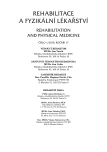The Use of 3D Kinematic Gait Analysis for Rehabilitation Purposes – the Vicon MX System
Authors:
Z. Svoboda; M. Janura
Authors‘ workplace:
Katedra biomechaniky a technické kybernetiky, Fakulta tělesné kultury UP, Olomouc
Published in:
Rehabil. fyz. Lék., 17, 2010, No. 1, pp. 26-31.
Category:
Original Papers
Overview
Gait analysis has its irreplaceable stance in the area of rehabilitation. In clinical practice, subjective gait evaluation is used with the aim of diagnosing disorder or injury. Quantitative measurements (scientific approach) are used with the aim of effectively evaluating the selected rehabilitation program.
Presently, sophisticated kinematic systems (the Vicon MX system belongs to this category) allow fast and accurate data processing. A combination of kinematic and dynamic systems (force plates) allows for a complex evaluation of the observed activity through the obtained data. Spatiotemporal variables are ranked among the most common variables along with angles between segments, components of ground reaction force and joint moments. This article includes fundamental information about performing gait analysis while using the Vicon MX system and refers to possible measurement output.
Key words:
gait analysis, kinematics, Vicon system rehabilitation
Sources
1. Baker, R.: Gait analysis methods in rehabilitation. J. Neuroeng. Rehabil., 3, 2006, 4, doi: 10.1186/1743-0003-3-4. ISSN 1743-0003.
2. Beard, D. J., Murray, D. W., Gill, H. S., Price, A. J., Rees, J. L., Alfaro-Adrian, J., Dodd. C. A. F.: Reconstruction does not reduce tibial translation in the cruciate-deficient knee. J. Bone Joint Surg. Br., 83-B, 2001, s. 1098-1103. ISSN: 0301-620X.
3. Canseco, K., Long, J., Marks, R., Khazzam, M., Harris, G.: Quantitative motion analysis in patients with hallux rigidus before and after cheilectomy. J. Orthop. Res., 27, 2009, s. 128-134. ISSN: 0736-0266.
4. da Fonseca, J. L., Magini, M., de Freitas, T. H.: Laboratory gait analysis in patients with low back pain before and after a pilates intervention. J. Sport Rehabil., 18, 2009, s. 269-282. ISSN: 1056-6716.
5. Dodd K. J., Morris, M. E.: Lateral pelvic displacement during gait: abnormalities after stroke and changes during the first month of rehabilitation. Arch. Phys. Med. Rehab., 84, 2003, 8, s. 1200-1205. ISSN: 0003-9993.
6. Follak, N., Merk, H.: The benefit of gait analysis in functional diagnostics in the rehabilitation of patients after operative treatment of calcaneal fractures. Foot and Ankle Surgery, 9, 2003, 4, s. 209-214. ISSN 1268-7731.
7. Gage, J. R.: Gait analysis in Cerebral Palsy. New York, Mac Keith Press, 1991. ISBN: 0521412773.
8. Graf, A., Hassani, S., Krzak, J., Caudill, A., Flanagan, A., Bajorunaite, R., Harris, G., Smith, P.: Gait characteristics and functional assessment of children with Type I Osteogenesis Imperfecta. J. Orthop. Res., 27, 2009, s. 1182-1190. ISSN 0736-0266.
9. Hesse, S. A., Jahnke, M. T., Schreiner, C., Mauritz K. H.: Gait symmetry and functional walking performance in hemiparetic patients prior to and after a 4-week rehabilitation programme. Gait Posture, 1, 1993, s. 166-171. ISSN: 0966-6362.
10. Janura, M., Zahálka, F.: Kinematická analýza pohybu člověka. Olomouc, Univerzita Palackého, 2004. ISBN: 8024409305.
11. Magyar, O. M., Illyes, A., Knoll, Z., Kiss, R. M.: Effect of medial meniscectomy on gait parameters. Knee Surg Sports Traumatol Arthrosc, 16, 2008, s. 427-433. ISSN 0942-2056.
12. Olsson, E. C.: Methods of studying gait. In G. L. Smidt (Ed.), Gait in rehabilitation (s. 21-43). New York, Churchill Livingstone Inc., 1990. ISBN: 044308663X.
13. Peppe, A., Chiavalon, C., Pasqualetti, P., Crovato, D., Caltagirone, C.: Does gait analysis quantify motor rehabilitation efficacy in Parkinson’s disease patients? Gait Posture, 26, 2007, s. 452-462. ISSN: 0966-6362.
14. RAMSEY, D. K., SNYDER-MACKLER, L., LEWEK, M., NEWCOMB, W., RUDOLPH, K. S.: Effect of anatomic realignment on muscle function during gait in patients with medial compartment knee osteoarthritis. Arthritis Rheum, 57, 2007, s. 389-397. ISSN 0004-3591.
15. Regnaux, J. P., Pradon, D., Roche, N., Robertson, J., Bussel, B., Dobkin, B.: Effects of loading the unaffected limb for one session of locomotor training on laboratory measures of gait in stroke. Clin.Biomech., 23, 2008, s. 762-768. ISSN: 0268-0033.
16. Siegel, K. L., Kepple, T. M., Stanhope, S. J.: A case study of gait compensations for hip muscle weakness in idiopathic inflammatory myopathy. Clin. Biomech., 22, 2007, s. 319-326. ISSN: 0268-0033.
17. Winter, D. A.: Biomechanics and motor control of human movement. 3rd ed. Hoboken, John Wiley & Sons, Inc., 2004. ISBN: 047144989X.
Labels
Physiotherapist, university degree Rehabilitation Sports medicineArticle was published in
Rehabilitation & Physical Medicine

2010 Issue 1
- Hope Awakens with Early Diagnosis of Parkinson's Disease Based on Skin Odor
- Deep stimulation of the globus pallidus improved clinical symptoms in a patient with refractory parkinsonism and genetic mutation
Most read in this issue
- Sarcopenia – Possibilities of Diagnostics and Influencing by Physiotherapy
- The Use of 3D Kinematic Gait Analysis for Rehabilitation Purposes – the Vicon MX System
- Assessment of Health State and Working Capacity of People Suffering from Nervous System Diseases
- Measurement of EMG Activity of Muscular Tissue after the Application of Whole-body Cool Therapy (- 130 °C)
